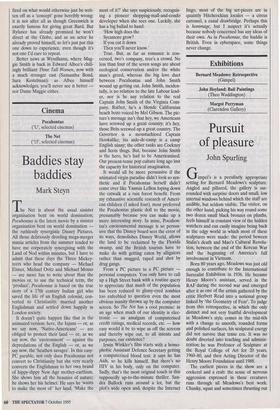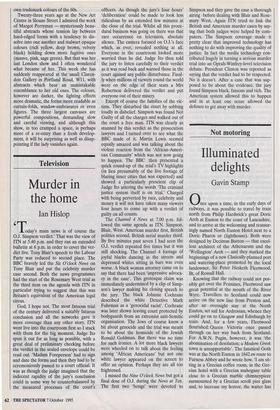Exhibitions
Bernard Meadows: Retrospective (Gimpel) John Hoyland: Bali Paintings (Theo Waddington) Margot Perryman (Clarendon Gallery)
Pursuit of pleasure
John Spurling
Gimpel's is a peculiarly appropriate setting for Bernard Meadows's sculpture. Angled and pillared, the gallery is sur- rounded with surprise doors and small, low internal windows behind which the staff are audible, but seldom visible. The visitor, on the other hand, picking his way round some two dozen small black bronzes on plinths, feels himself in constant view of the hidden watchers and can easily imagine being back in the edgy world in which most of these sculptures were made: the period beween Stalin's death and Mao's Cultural Revolu- tion, between the end of the Korean War and the beginning of America's full involvement in Vietnam.
Born 80 years ago, Meadows was just old enough to contribute to the International Surrealist Exhibition in 1936. He became Henry Moore's assistant, served in the RAF during the second war and emerged after it as one of the artists gathered by the critic Herbert Read into a notional group linked by 'the Geometry of Fear'. To judge from this retrospective, in which the only distinct and not very fruitful development in Meadows's style comes in the mid-60s with a change to smooth, rounded forms and polished surfaces, his sculptural energy did not survive that tense era. It was no doubt diverted into teaching and adminis- tration: he was Professor of Sculpture at the Royal College of Art for 20 years, 1960-80, and then Acting Director of the Henry Moore Foundation until 1988.
The earliest pieces in the show are a cockerel and a crab: the sense of nervous aggression expressed in these creatures runs through all Meadows's best work. Chunky, squat and sometimes thrusting out an unpleasant spike where an arm could be, the human figures have flattened heads like pill-boxes, spindly legs and bulkily armoured torsos. It is as if, calcified in burning tanks, crippled by explosives or partly fused with the ruins of bombed buildings, they have nevertheless crawled out to renew their mutually destructive claims to power and territory. No written account of that time could convey, as suc- cinctly as these baleful humanoid crus- taceans do, what it was like to pass straight from the Hot War into the Cold.
John Hoyland, whose first one-man show was in 1964, belongs to a luckier genera- tion. He and his fellow abstractionists — both sculptors and painters — working on a large scale, with radically cheerful colours, were able to burst through their predecessors' clenched gloom and envisage a new, expansive world, if not of politics than at least of the emotions. In place of the Geometry of Fear they proposed, one might say, the Geometry of Pleasure. For many of them that optimism hardly outlast- ed the 60s, but Hoyland has never aban- doned colour, size or abstraction and has pursued his pleasure principle with ener- getic dedication and extraordinary fertility these 30 years. It is pointless to complain, as even his admirers regularly do, of his seeming inability to distinguish bad from good, his determination to get paint on to canvases in almost indiscriminate profusion on to the walls of galleries. These are the terms on which he operates. His creativity is not in the preparation or contemplation, but in the doing.
All but one of the 27 large and 15 small 'Bali Paintings' at Theo Waddington were painted this year. Their forms are organic, suggesting branches, creepers or waterfalls in hectic combinations of brilliant colour. But, as always in Hoyland's work, there are several layers of action with different speed markings, like a piece of music laid out in space rather than time. On top of the high- ly active principal forms (presto) are the still more frenzied dots and splashes of fly- ing pigment (prestissimo), as well as bead- ings of the stuff squeezed straight from the tube; while at bottom and sides are more solid, slower bands or patchworks of colour (andante) and behind all, calm and almost static (lentissimo), the matt, light-absorbing background of blended blues or greens.
Combining all these layers must be for Hoyland an open-ended, improvised per- formance, but for the viewer, of course, the finished thing contains only echoes of the original performance. These two opposing standpoints can perhaps be reconciled by telling oneself that, after all, part of the pleasure of a Hoyland show is picking out the performances that still work in retro- spect. My choices here are the sombre 'Tree Message', the violent 'Dream of Trees', the mysterious 'Tree of Light' and the romantic 'Before Memory Fades', red against luminous jungle-green, a homage perhaps to Matisse, but also to Hoyland's own trademark colours of the 60s.
Twenty-three years ago at the New Art Centre in Sloane Street I admired the work of Margot Perryman — mysteriously beau- tiful abstracts whose tension lay between hard-edged forms with a tendency to dis- solve into one another and stalwart opaque colours (rich yellow, deep brown, velvety black) holding down more fugitive ones (mauve, pink, sage green). But that was her last London show and I often wondered what became of her. This week she has suddenly reappeared at the small Claren- don Gallery in Portland Road, W11, with abstracts which bear an unmistakable resemblance to her old ones. The colours, however are darker, the lighting effects more dramatic, the forms more readable as curtain-folds, window-embrasures or even figures. The three largest canvases are powerful compositions, demanding slow and careful viewing, and although this show, in too cramped a space, is perhaps more of a re-entry than a fresh develop- ment, it will be surprising as well as disap- pointing if the lady vanishes again.












































































 Previous page
Previous page